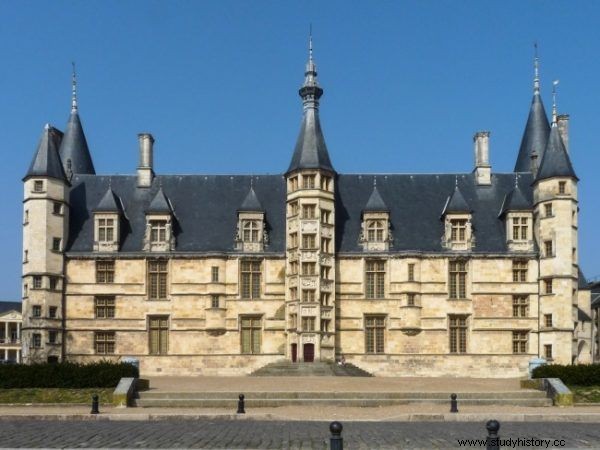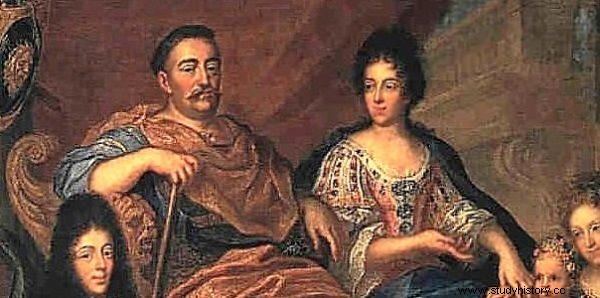Her love letters ignite the imagination to this day. She was one of the few rulers to experience marital happiness. Yet her subjects hated her. In her youth, she was considered a pet of the queen, a French agent and an illegitimate daughter. Right?
When Ludwika Maria Gonzaga de Nevers left for Poland to marry King Władysław IV Vasa, little was behind her. She had no imperial parent, no army, and no wealthy purse. Influence had to be won in her own way. To this she harnessed hosts of her fanatically devoted beauties and the Polish royal court was swarming with young and beautiful French women.
Their only task was to fall in love with the most brilliant magnate, marry him and turn him into a faithful supporter of the queen and the court. Among the queen's beautiful army, her favorite, in the future, Queen Marysieńka, was the highest. Before she married the later Jan III, however, she was quite a little girl who came to Poland probably at the age of four.
Maria Kazimiera d'Arquien de La Grange's early childhood is obscured by a haze of mystery. She was probably born on June 28, 1641 in Nevers. This beautiful town in the south of France is known primarily as a place of pilgrimage.

Prince's Palace in Nevers. It was here that the future Queen Louis Maria Gonzaga lived. Perhaps in one of the chambers her godmother Marysieńka was born? (photo:Aleksandra Zaprutko-Janicka)
Christians come to the tomb of St. Bernadette who had an apparition in Lourdes. For pilgrims from Poland, an additional attraction may be the fact that two of our queens came from this small Burgundian town.
Although Nevers may call itself a motherland of Polish crowned heads, it is difficult to find any trace of it in the town. Ludwika Maria Gonzaga lived to see only the car park named after him. Marysieńka - she didn't even get that much.
Whose child is this really?
Marysieńka was the daughter of Henryk Albert de la Grange d'Arquien and his wife, Franciszka de la Châtre, taking into account malicious rumors, at least she had the surname. The girl's godmother was the ruler of her hometown, Princess Ludwika Maria Gonzaga. Marysieńka's parents got married in 1634 and had seven children. As Sobieska's biographer, Michał Komaszyński, queen's father Henryk writes:
He served with the Duke of Orleans Gaston, brother of King Louis XIII of France, as captain of the Swiss Guard. The spouse of the Marquis Françoise de la Châtre was the steward of Newer Princess Maria Gonzaga.

The article was inspired by the book by Robert Forys called "Gambit hetmański" (Otwarte Publishing House 2016). It is a fascinating story about women who, above all else, crave power. They are ready to pay for it with gold, blood, poison, and even - with their own body ...
When Ludwika Maria was chosen as the wife of the Polish king and after her wedding per procura set off for Warsaw, despite the prevailing winter and the dangers of the journey, she took with her a few-year-old goddaughter.
Apparently, the future Polish queen wanted to relieve her parents, who were far from wealthy. There is also a second explanation for picking up a girl from her mother so early. Rumors soon spread that Ludwika Maria Gonzaga was guided by… maternal love.
Reluctant French gossipers claimed that little Marysieńka was in fact the illegitimate daughter of Ludwika Maria, who came from her affair with Henryk d'Effiat, Marquis de Cinq-Mars. The girl's alleged father, who was beheaded in France for treason on the orders of Cardinal Richelieu (the one of the Musketeers), was to be the Queen's only true love.

Ludwika Maria's entry into Gdańsk. Somewhere in the crowd immortalized in the painting, there is a four-year-old terrified girl. Later Queen of Poland, Maria Kazimiera Sobieska.
Fatherhood was also attributed to Prince Condeusz, who was related to Louis XIV. The "kind" reported it to our Władysław IV Waza, adding that the alleged bastard was proof of the queen's misfortune before the wedding. But the king… didn't really care.
He certainly knew what a lush past his wife had behind her. For him, something else mattered:a considerable dowry, funded by the king of France, who was already counting the next army troops and bribes.
This article has more than one page. Please select another one below to continue reading.Attention! You are not on the first page of the article. If you want to read from the beginning click here.
Frenchwoman Marie is our Marysieńka
Little is known about the first years of Miss d'Arquien at the Polish court. What is certain is that the girl grew up in the immediate vicinity of the queen. According to Komaszyński, under the watchful eye of the mansion - Mrs. Galman. The Polish courtiers of Ludwika Maria very quickly baptized the charming four-year-old Frenchwoman Marie Casimire with the familiar and caressing name:Marysieńka.

When the Chmielnicki uprising lasted, Sobieski and Marysieńka (in the picture) were on two distant ends of Europe. She was educated in Nevers, where her teenage charm was slowly blossoming, and he fought bravely with rebellious boots in war-torn Ukraine.
In her new homeland, she learned Polish easily, without forgetting her native French, which was her main language. This will be seen in her later letters, in which she constantly mixes these languages. Nobody blamed her for that. At the end of the 17th century, a similar kogiel mogiel was even considered fashionable.
He weaves Polish words and phrases with absolutely horrible spelling into his mostly French-language correspondence. She did not master other languages, even Latin, so widely used by the Sarmatians.
Breakups and Returns
In 1648, the fate of Queen Louise Maria Gonzaga became extremely uncertain. Her husband died and her health deteriorated badly. It took several months for the situation to clear up. Two of his brothers competed for the crown and inheritance after Władysław IV, both of them holding church dignities.

The article was inspired by the book by Robert Forys called "Gambit hetmański" (Otwarte Publishing House 2016). It is a fascinating story about women who, above all else, crave power. They are ready to pay for it with gold, blood, poison, and even - with their own body ...
The widow sided with Jan Kazimierz, who was elected king. At the same time, the Chmielnicki uprising continued in the Commonwealth. What was Marysieńka doing? During this dangerous period, her godmother sent her to France. There, Miss d'Arquien was educated by nuns in her hometown of Nevers. It was certainly an opportunity for her to renew her ties with her family. Or rather, to build these bonds. In fact, she had no right to remember her biological family.

The charming streets of Nevers (pictured), the closeness of the family, a milder climate, and perhaps patient teaching of the Ursulines and aunts made France forever occupy a special place in the heart of Marysieńka. (Photo:Aleksandra Zaprutko-Janicka)
We do not know the exact date of Marysieńka's departure, but it is known that her education was not limited to the walls of the Ursuline nunnery in Nevers. She spent part of her stay in France with her father's sister, Countess de Maligny. During this time, was undergoing an accelerated course of familiarity and manners at this old friend of Ludwika Maria.
The teenage Miss d'Arquien returned to Poland in 1652 or 1653. Interestingly, as Marysieńka's biographer proves, during his stay in France, Louis XIV tried to win her over . He was well aware of how close the girl was to the heart of the Polish queen. He wanted to make her a faithful supporter of France on the Vistula.
What was young Marysieńka really like?
After returning to Poland, Marie Casimire found herself again in the immediate vicinity of the queen. In later years, when the black legend of Sobieska began to form, people were lost in conjecture about her upbringing and it was repeated that Ludwika Maria completely dissolved her.
The Queen caressed this young, extraordinarily pretty child, because she had no limits to her attachment to her, so broke her completely. She made her a proud, capricious, greedy for power and exaltation, a selfish virgin. (M. Komaszyński, "Beautiful Queen")

The remains of the city walls in Nevers, the lair of Polish queens. (photo:Aleksandra Zaprutko-Janicka)
However, Jan Andrzej Morsztyn was less critical of Marysieńka. Perhaps, when composing his stanzas, he wanted to please the queen, or maybe he just liked Miss d'Arquien? Whatever his motive, years later he ended up as one of the participants in the conspiracy to dethrone the king, founded by Marysieńka and Jan Sobieski. Robert Foryś neatly uses this motif, weaving the fate of these three in his latest novel ("God, honor, poison", Wydawnictwo Otwarte 2014). Meanwhile, here is what Mr. Morsztyn had to say about Maria Kazimierz when he was young:
This first face, though last years,
Born among polite Frances,
She is capable of burning both worlds to ashes -
From sunrise to where it dives ...
They come together in this angelic body
Wit and reason no less surely holy,
Almost from the blue one went parantele,
Because all gods have a treasure locked up in it;
From here the gifts of the heart carry her,
As to the church and to the Ark ... (quoted after:T. Boy-Żeleński, "Marysieńka Sobieska"
But what about the origin of Marysieńka? Was she really the queen's bastard? It seems very unlikely. Although - we will never be sure.
